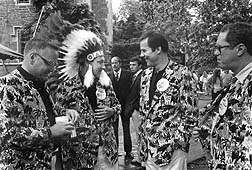 From the Archives
From the Archives
Class Notes - May 17, 2000
Class notes features
At the 25th reunion for the Class of 1957, New Jersey governor Tom Kean
(second from right) was spotted chatting with fellow classmates, including
Dean Groel, the one with the feathers, and two others, whose identities
are unknown to paw. That year, 1982, the class got into a bit of a brouhaha
over its class poll. The senior class took offense at a question deemed
racist and carried banners in the P-rade proclaiming "Princeton Needs
More Minorities" and "End Racism."
Sundays on the radio with John
Cee-deejay John Platt '70 plays freely on public radio
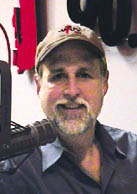 The hypnotic chorus to Sloan Wainwright's "Across
the Universe" floats through the WFUV studios in the Bronx as John
O. Platt III '70 sits in front of a small radio console, writing notes into
a large, spiral notebook. CDs from Tom Rush, Cheryl Wheeler, and other artists
sit neatly upon his desk. Slowly, as the music quiets, Platt-who wears reading
glasses and has a trim gray beard-leans over to the microphone.
The hypnotic chorus to Sloan Wainwright's "Across
the Universe" floats through the WFUV studios in the Bronx as John
O. Platt III '70 sits in front of a small radio console, writing notes into
a large, spiral notebook. CDs from Tom Rush, Cheryl Wheeler, and other artists
sit neatly upon his desk. Slowly, as the music quiets, Platt-who wears reading
glasses and has a trim gray beard-leans over to the microphone.
"At 90.7 WFUV, we kind of pick up from where last week's show ended," Platt says, his voice mellow, but weighty. "The last hour we had Loudon Wainwright as a guest and some of the songs of John Lennon. Well, there's Loudon's sister Sloan doing a John Lennon song."
The song suits Platt, a radio veteran with a taste for new music. For the last 30 years he has worked as a producer, program director, and occasional on-air host for various radio stations in New York, Philadelphia, and Chicago. These days, he brings this experience to his Sunday-morning radio show on WFUV, a preserve for contemporary singer-songwriters. At a time when many of his colleagues have been phased out by the increasing dominance of the top-40 format and the collapse of rock fortresses like WNEW in New York, Platt has found a refuge in public radio.
"I can start each day knowing I'm going to work at a station where the air staff and the audience share a passion for the music," Platt says.
In a day when most playlists are put together by committee, Platt picks his music himself-usually while sitting in traffic on the Cross-Bronx Expressway on his way home from work-using seasons, birthdays, and anniversaries as his inspiration. (This morning's set of John Lennon songs marked the 59th anniversary of the singer's birth.) New Yorkers may be familiar with Platt's methods: He learned many of his tricks while producing Pete Fornatale's award-winning Mixed Bag on WNEW from 1985 to 1989. The show, a Sunday-morning folk and acoustic program which featured the likes of Christine Lavin, Richie Havens, and Tom Chapin, was one of the last to be produced thematically.
Born in Philadelphia in 1948, Platt came of age musically at Princeton during the late 1960s. As a student, he found his niche playing Jimi Hendrix and Jefferson Airplane on WPRB.
After graduating, Platt worked at WMMR in Philadelphia before moving to Chicago to become program director of WXRT, an innovative free-form rock station where he discovered folk icons like Steve Goodman and blues legends like Howlin' Wolf. In the early 1980s, Platt moved to New York City to become program director of WRVR, a progressive jazz station. When WRVR changed format, he did promotion work for WNEW-AM while producing for Fornatale at WNEW-FM and then at K-Rock.
At WFUV, Platt is free to indulge all of his musical tastes. His show, which often includes interviews with artists like Mary Chapin Carpenter or Wainwright, is a blend of rock, folk, and jazz.
Still, Platt-who lives with his wife and college-aged children on Long Island's north shore-has made some sacrifices to work at WFUV. While public radio allows him a certain artistic freedom, it must rely heavily on financial support from its audience-making his salary modest, at best.
Nevertheless, Platt knows he made the right decision when he moved to public radio in the summer of 1997.
"I feel so blessed," Platt says, leaning back in his office chair. Muddy Waters and a young Bruce Springsteen stare from photos on his wall. "There just isn't a place in commercial radio to do something where you have this kind of opportunity."
-Maurice Timothy Reidy '97
Peril for an arrogant Princetonian
Watch out, or author Tom Paine '84 might place you in terrible danger
in his next book
For writer Tom Paine '84, inspiration came from Annual Giving.
As Paine tells it, a friend from his Tiger Inn days called for the university fundraising campaign several years ago and said, "I've got you down for a grand." Paine was shocked by the assumption that he had $1,000 to spare: Working as a carpenter at the time, he barely had enough cash to buy beer.
In a rage, Paine started writing a story about a rich, arrogant Princeton alumnus. He put the character on a boat and proceeded to try to drown him.
The result, a powerful adventure tale titled "Will You Say Something, Monsieur Eliot?", is one of 10 stories collected in Paine's first book, Scar Vegas, published in January by Harcourt. The stories, which range from Saudi Arabia to the Caribbean and feature a skateboarding punk and a U.S. general in women's underwear among their characters, include the winners of one O. Henry award and two Pushcart prizes.
The collection has brought more praise to Paine, a 37-year-old who lives in Charlotte, Vermont, with his wife and young daughter and teaches writing at Middlebury College. In addition to positive reviews from The New York Times, the online magazine Salon, and others, he's won the number-1 spot in Esquire magazine's index, and the top 10 of Talk magazine.
But the first story Paine ever published was the one about the rich Princeton alumnus. In fact, another Princeton connection helped get it into print: After reading in paw about an alumnus who works at The New Yorker, Paine sent the man a copy of his story, which he had previously submitted there to no avail. The fellow Tiger liked the story enough to pass it on to the fiction editor, who decided to publish it.
Yet Princeton hasn't always been such a positive influence on Paine. While an undergraduate, he didn't find a niche for artistic expression at the university. Not accepted into the creative writing workshops and turned off by the English department's analysis of literature he read for pleasure, he found his college experience barren.
"I came there with a lot of creative spiritual yearning, and it absolutely did not find a home there," he recalls. "Now that I am in my 30s, I can blame myself, but there was a time in my 20s when I was furious, and I blamed the school for not having enough of an atmosphere that there was an alternative future to lawyer-doctor-Wall Street."
Paine majored in the history of science and wrote his thesis on the search for the proper role of technology in society. His current work still asks how soul and love of beauty survive in a high-tech world.
Paine says he doesn't intend to write political stories, but his leftist attitudes slip out, like strands of his brown hair loosening from its ponytail. More than making political points, he seems intent on grabbing readers with what he calls his "fully equipped, motorized plots."
"My dictum is, if you bore yourself, you bore the reader," he says. "I like action. I like explosive narrative. Without strong narrative, there's no way you're going to capture America now. It's sort of blue-collar of me."
A graduate of Columbia University's master's program in creative writing, Paine says that in the literary world, "you get trained to write a story driven by a minute epiphany . . . that's about as heavy as a single teardrop."
He doesn't like reading such stuff or writing it. Rather than turn inward to analyze his middle-class upbringing in Rhode Island, he'd rather write good adventure stories, like the one about the Princeton man adrift at sea.
Paine says the secret reader in his mind is his father, a dentist who reads very little and would have preferred his son to be a doctor. "I think, 'Is this going to bore Dad?'"
Judging by the response to his book, Paine's many readers are far from bored. While O. Henry awards and good reviews don't cash out like his Princeton peers' stocks and bonds, the author seems at peace with his sometimes difficult decision to keep writing.
"The doing of it is the pleasure. You become self-sustaining," Paine says. Then, with a smile, he adds, "I don't have any more urges to go to medical school."
-Heather Stephenson '90
Heather Stephenson is a writer based in Vermont.
So what's so interesting about nothing?
Zero turns out to be something more than the sum of its parts
Greeks couldn't do this neat little mathematical trick. They didn't have the concept of a limit because they didn't believe in zero. The terms in the infinite series didn't have a limit or a destination; they seemed to get smaller and smaller without any particular end in sight. As a result, the Greeks couldn't handle the infinite. They pondered the concept of the void but rejected zero as a number, and they toyed with the concept of the infinite but refused to allow infinity- numbers that are infinitely small and infinitely large-anywhere near the realm of numbers. This is the biggest failure in Greek mathematics, and it is the only thing that kept them from discovering calculus. (Excerpt from Zero: The Biography of a Dangerous Idea)
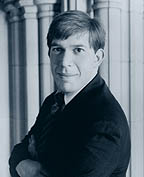 Charles Seife '93 recently published his first book, Zero: The Biography
of a Dangerous Idea, which details the history of the no-number and
the people who battled over its meaning. A mathematics major at Princeton,
Seife went on to earn a master's in math at Yale and is now a writer at
Science magazine. Louis Jacobson '92 spoke to him about the concept of zero.
Charles Seife '93 recently published his first book, Zero: The Biography
of a Dangerous Idea, which details the history of the no-number and
the people who battled over its meaning. A mathematics major at Princeton,
Seife went on to earn a master's in math at Yale and is now a writer at
Science magazine. Louis Jacobson '92 spoke to him about the concept of zero.
Q: How did you first get interested in zero?
A: After I graduated from Princeton and was getting into science writing, I was looking for a book project. I became interested in infinity because I had taken a course with Professor John Conway that got into the transfinite and surreal numbers. According to those theories, there are actually an infinite number of infinities. I thought that was a very interesting topic. Just as I was about to get a book proposal together, there were a few articles on the millennium and why the lack of a Year Zero in our calendar messed things up and caused the debates on whether 2000 or 2001 was really the beginning of the millennium. It seemed to strike a chord with the public, so I decided to turn my original idea on its head.
Q: Why did it take so long for zero to become accepted in mathematics?
A: It conflicted with the Western view of numbers and Western philosophy-for millennia, really. The Western view of the universe was based on the Greek world view, which believed that the universe was built on rational numbers. When you introduced zero into this nice, neat rational universe, it just blew everything up. It did not fit into the philosophy of Aristotle, which lasted until the time of Shakespeare.
Q: But zero was accepted outside the West.
A: In Eastern cultures there was no Aristotle, so the concept of both a void and infinity was more acceptable. The first glimpse of zero came with the Babylonians, though their zero was a placeholder zero-it just separated certain kinds of numbers from other kinds. It was in India that zero really became the zero we know-something that separates the positive numbers from the negative numbers. Zero also arose in Mayan culture totally independently. In fact, the Mayans started with a Year Zero. They would not have had the millennium problem.
Q: When did the West finally come around?
A: The old philosophy started falling apart in the late 13th century. Church elders questioned whether Aristotelian philosophy could be superseded by God. Aristotelians said there cannot be such a thing as a vacuum, but the bishops countered that God could create one if he wanted. But once the Protestant Reformation got going, that thinking reversed itself again and the church fell back on its old Aristotelian foundations. It really took three centuries more until you got Copernicus, Galileo, and Newton.
Q: Are there any heroes in your story?
A: There's a bit of a hero and a villain in Pythagoras. He was a bizarre character, but also a genius. He was a brilliant mathematician and was very important for the development of geometry, but his philosophy kept the West from developing for 2,000 years. His idea was that the universe was rational, that numbers guided the universe, that the planets circled the Earth. It was a direct precursor of Aristotelian thinking.
Q: So what year do you think is the real turn of the millennium?
A: I say it's 2001. But I'm all in favor of partying twice.
-Louis Jacobson '92
Louis Jacobson is a staff writer for National Journal.
Rescuing Ernest Hemingway from political
incorrectness
Charles Riley '79's magazine for people with disabilities scores
literary coup
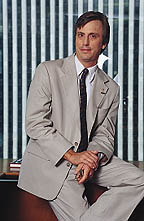 Last year, when We magazine nailed down rights to reprint
excerpts from Ernest Hemingway's posthumous novel, True at First Light,
this literary coup raised more than a few eyebrows. For one thing, despite
having a circulation of 300,000, the Manhattan-based publication is only
three years old and is still very much a new title on the stands. For another,
as its cover states, We is a magazine "for people with disabilities,
their families and friends"-a group most people don't associate with
the big-game hunting, deep-sea fishing author.
Last year, when We magazine nailed down rights to reprint
excerpts from Ernest Hemingway's posthumous novel, True at First Light,
this literary coup raised more than a few eyebrows. For one thing, despite
having a circulation of 300,000, the Manhattan-based publication is only
three years old and is still very much a new title on the stands. For another,
as its cover states, We is a magazine "for people with disabilities,
their families and friends"-a group most people don't associate with
the big-game hunting, deep-sea fishing author.
But that, as We's editor-in-chief, Charles Riley II '79, will tell you, is exactly the point. "When people think of disabilities, they automatically think of someone who is blind or deaf or in a wheelchair," says Riley, who has no disability other than weak eyesight, for which he wears a pair of glasses. "But there are many, many people walking around with hidden disabilities, like respiratory ailments, diabetes, mental disabilities, and recovery from alcohol or drug addiction. In fact, one out of five Americans has some sort of disability."
Hemingway had to contend with poor eyesight in his left eye from birth as well as injuries from mortar wounds in World War I and from two plane crashes later in life-not to mention diabetes, bouts of depression, and alcoholism. "You have rescued Hemingway from political incorrectness," publisher Charles Scribner told Riley when he phoned to okay the deal.
More accurately, Riley and his tight-knit staff are demonstrating that a caring, straightforward approach to a difficult subject can transcend the concept of political correctness. The magazine's covers have celebrated the courage of Michael J. Fox (who went public about his seven-year struggle with Parkinson's disease), the journalistic skills of NBC's John Hockenberry, and the emotional virtuosity of violinist Itzhak Perlman, who contracted polio as a child. "Our profiles tend to emphasize what someone has accomplished, rather than dwelling on a specific disability," says Riley.
That's not to say the magazine doesn't face disability issues head on: We's articles range from a report on the first ascent of Mount Everest by a disabled climber to fashion spreads of stunning-looking models (all of whom are disabled), medical news, and reviews of new technology. The magazine also contains commentary on political topics, including the ongoing court challenges to the landmark 1990 Americans with Disabilities Act.
On leave from Baruch College, where he's a tenured professor of literature and journalism, Riley cofounded We with the well-known Vietnam veteran and advocate for the disabled Terry Moakley. "I'd been coasting as a teacher, and I wanted to do something that would make a difference," Riley says.
To date, Riley and team seem to be satisfying the demands of the disabled community and investors. After being near insolvency a couple of years back, an infusion of funding combined with solid advertising growth has put the glossy publication on firm footing. Essays by the likes of Oliver Sacks and Bill Moyers haven't hurt, either. "We've gotten a lot of praise for our coverage and our appearance," says Riley. "But we have to be good. To be taken seriously, we need to be able to compete with the very best magazines in terms of content and production values."
-Royce Flippin '80
Royce Flippin is a freelance writer living in New York City.
Looking for a fight
Featherweight Anju Reejhsinghani '93 likes to hit
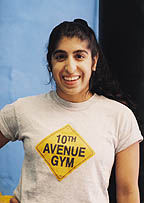 I get satisfaction from hitting people," says Anju Reejhsinghani
'93, her eyes flashing. In 1994, she was enrolled at the London School of
Economics and realized that what she really wanted to do was box. As a kid,
her brothers were using her as their punching bag, so their parents gave
her boxing gloves. In the gloves, the now 5'2", 125-pounder discovered
she had something in common with Sugar Ray Leonard, Muhammad Ali, Marvin
Hagler, and the other heroes she used to watch on television: She had power.
I get satisfaction from hitting people," says Anju Reejhsinghani
'93, her eyes flashing. In 1994, she was enrolled at the London School of
Economics and realized that what she really wanted to do was box. As a kid,
her brothers were using her as their punching bag, so their parents gave
her boxing gloves. In the gloves, the now 5'2", 125-pounder discovered
she had something in common with Sugar Ray Leonard, Muhammad Ali, Marvin
Hagler, and the other heroes she used to watch on television: She had power.
But what to do with that power? Women's boxing is in its infancy and its ranks are thin. Reejhsinghani has fought only one official match against a woman, a split decision she lost in the Southwest Texas Golden Gloves Regionals last year. She fought as a 132-pounder, but is now a featherweight at 125 and is preparing for the Washington State Boxing Championships for men and women at Yakima, followed by the Women's National Championships in Midland, Texas, both later this spring.
She trains in Seattle at the 10th Avenue Gym and Skid Row Boxing Club,which she owns with her coach and life partner, Bill Geoghegan, a devotee of kick-boxing.
In the gym, which is furnished with two six-foot-tall banana bags, a Wing Chun dummy, a dozen heavy bags, uppercut bags, water bags, doubled-ended balls, and speed bags, a 14-foot white canvas boxing ring roped in red rises like an island.
Reejhsinghani and Geoghegan teach daily classes in the martial arts and manage the business, the accounting, the promotion, the clean-up. "The two of us take turns freaking out," she says. "Making the rent is the biggest expense, after the cost of the equipment."
Reejhsinghani trains six days a week. She runs 3 to 5 miles a day, punches her way through the gauntlet of bags 5 to 6 rounds at a time, skips rope for 30 minutes, adds 15 minutes with a medicine ball, 20 minutes on the abs, and then, three days a week, spars 3 to 5 rounds against men. Geoghegan referees the sparring.
"I love to spar, to get in there and mix it up. For my size, I'm more of a power puncher. The head is worth more points, but in the pros, body punching is how you hurt someone.
"Whether I go pro depends on how good I get. To be a boxer-and a writer-that's my ideal," she says. "I'm not writing right now." Reejhsinghani explains she has already written one book of short fiction. She's also pursuing a master's degree in Latin American history at the University of Texas, to which she commutes periodically. She wrote her Princeton thesis on women in colonial India.
Reejhsinghani was born in Wilbraham, Massachusetts, near Springfield. Her parents are Hindus who left Pakistan in 1947 just before the country was divided.
"Dad was an engineer, mom a physician, a pediatrician who later ran her own business," Reejhsinghani says. "I wanted to be an engineer. Princeton physics changed that. I was on the debate team at Princeton and we reached the world championships. I also took a self-defense class."
She compares career aspirations with those of her Princeton friends: one is getting an MBA, another is finishing a master's in architecture, and a third, a woman, is flying jet fighters. She seems right on track.
-Dan White '65
GO TO the Table of Contents of the current issue
GO TO
PAW's home page